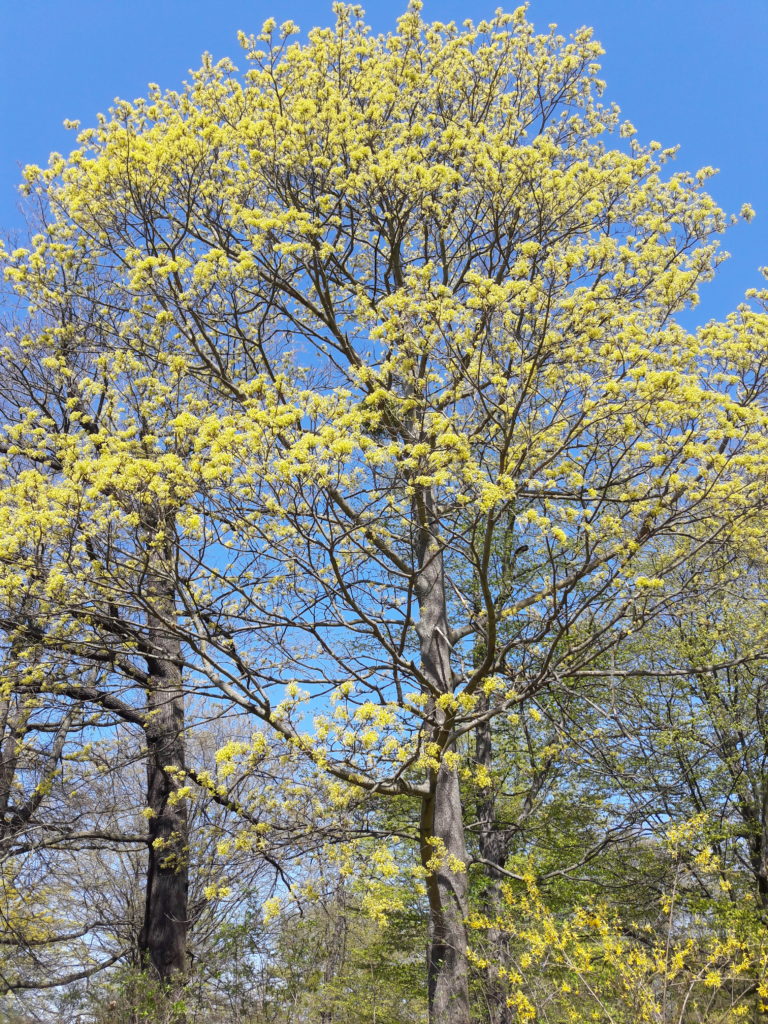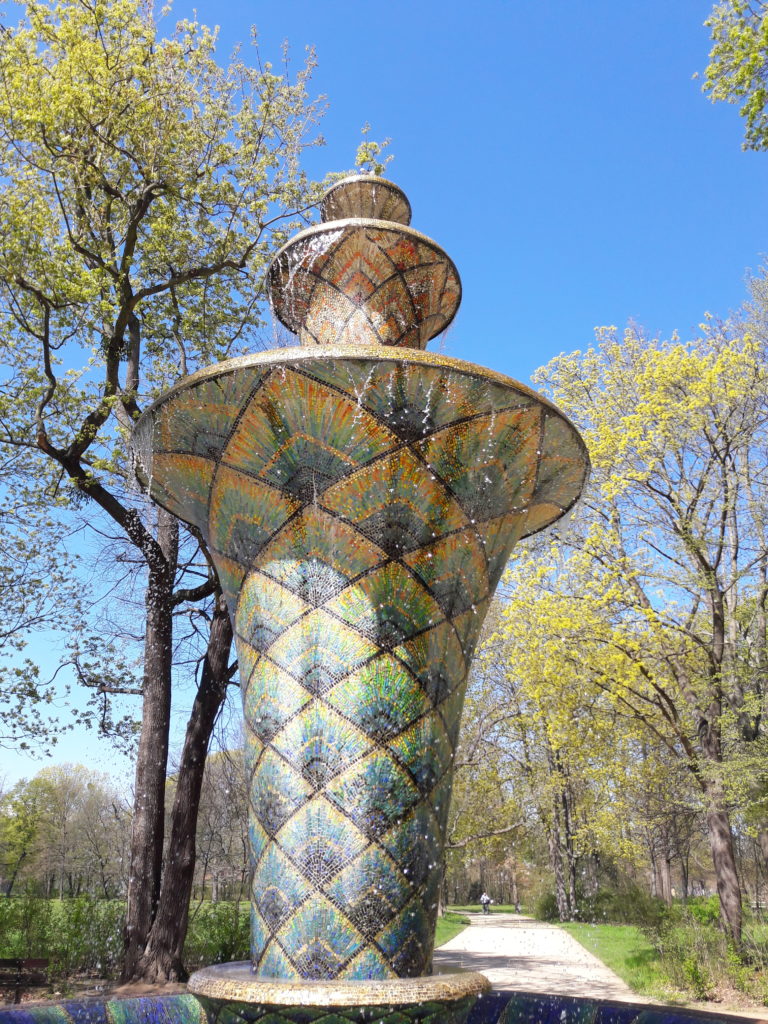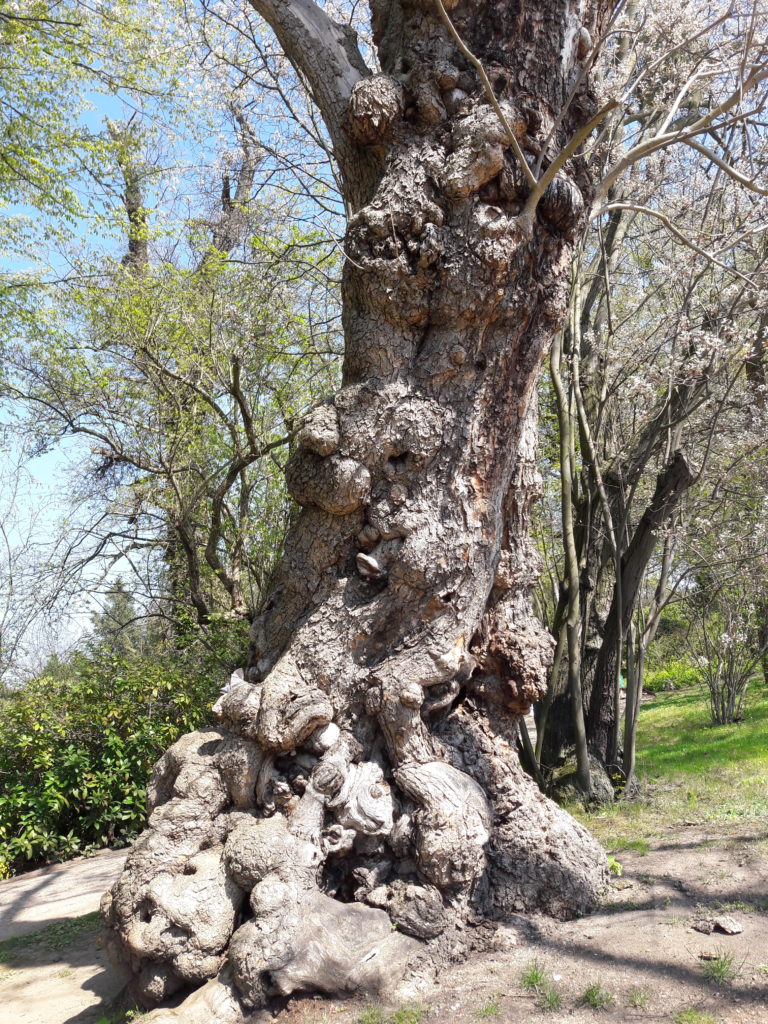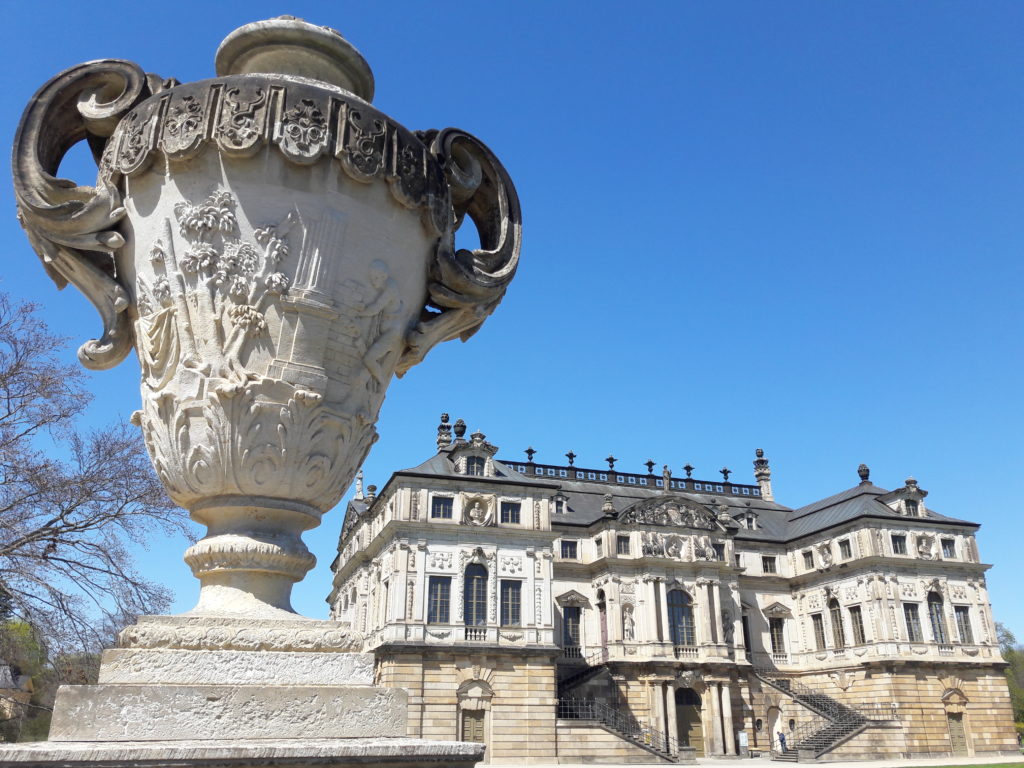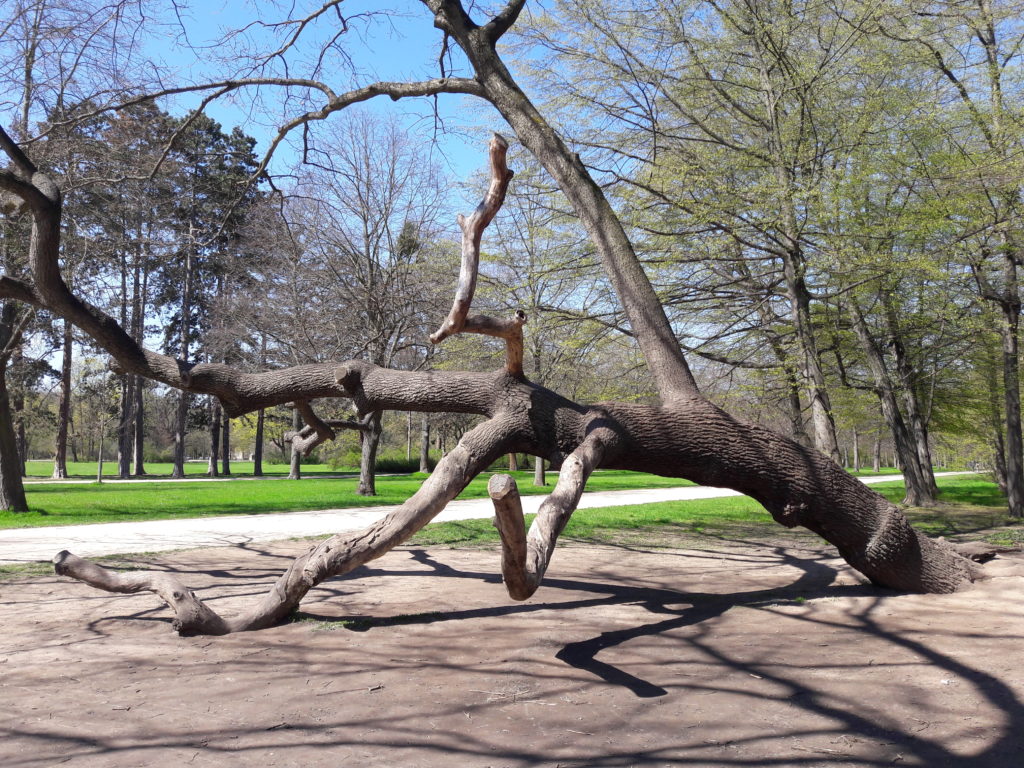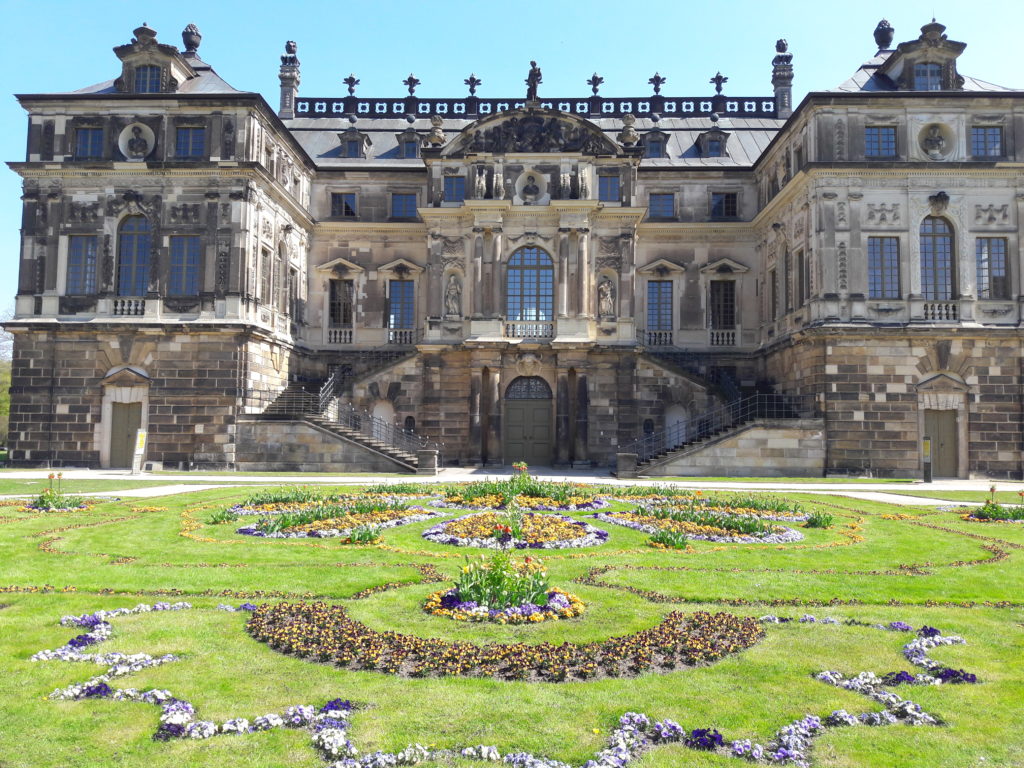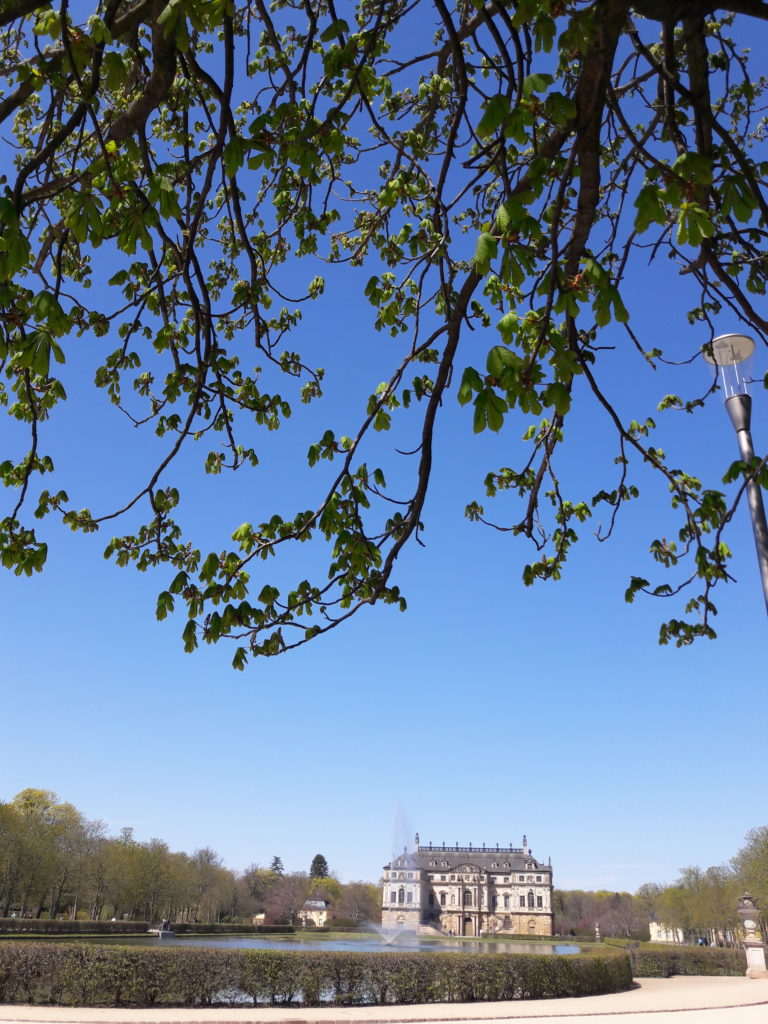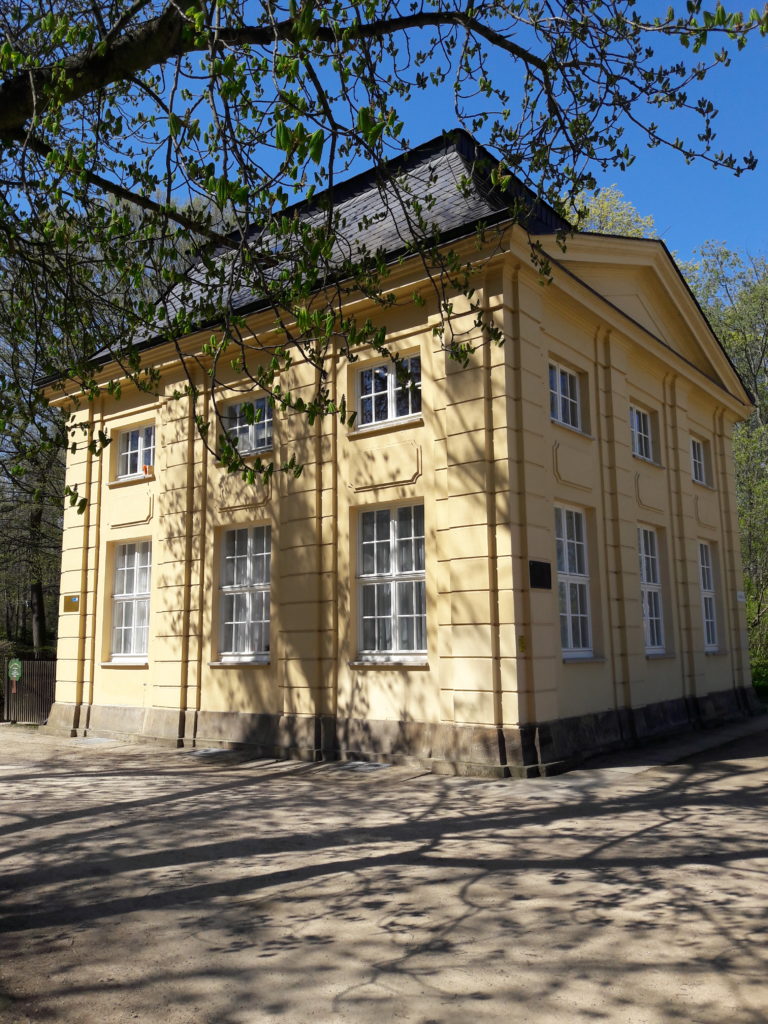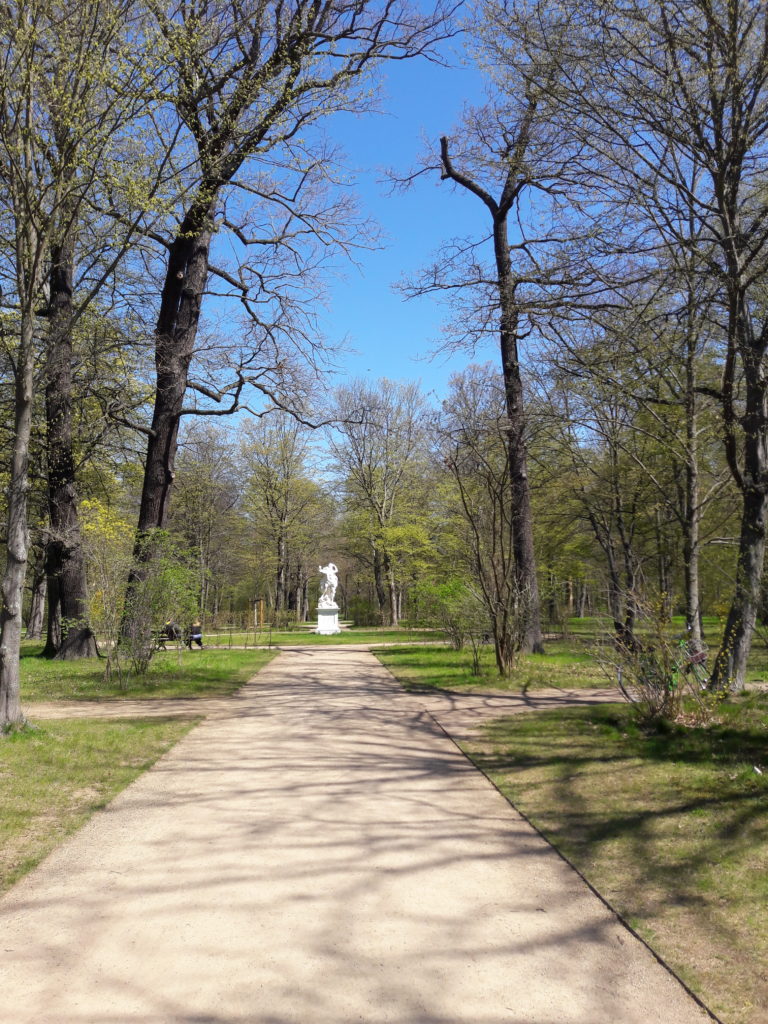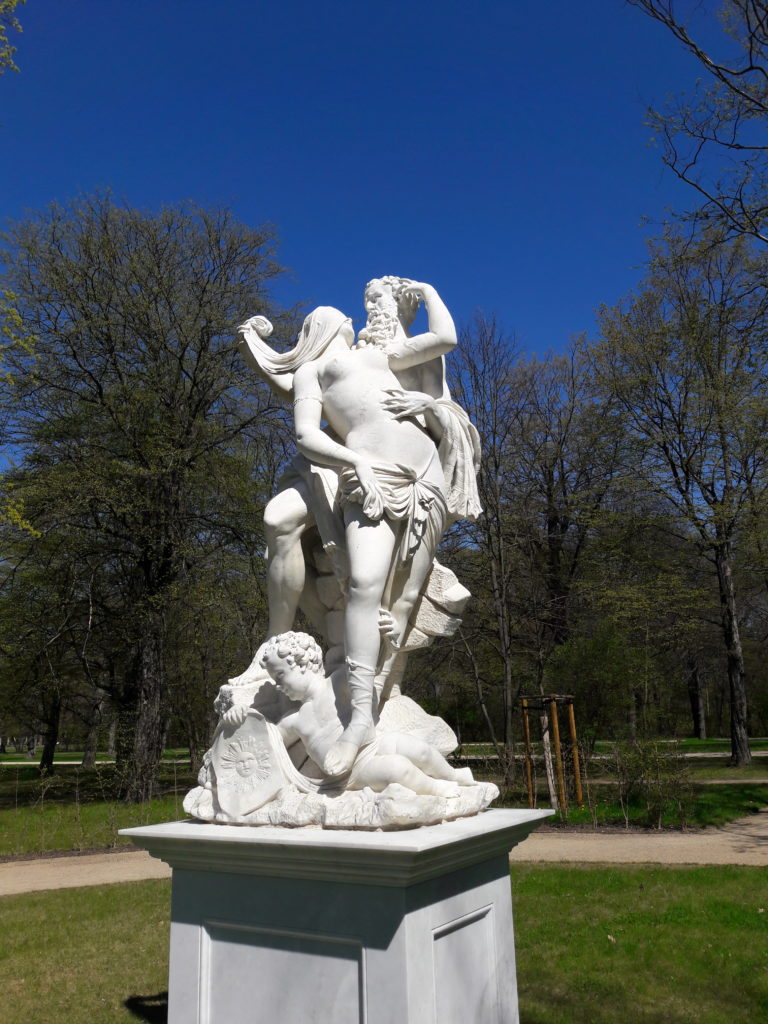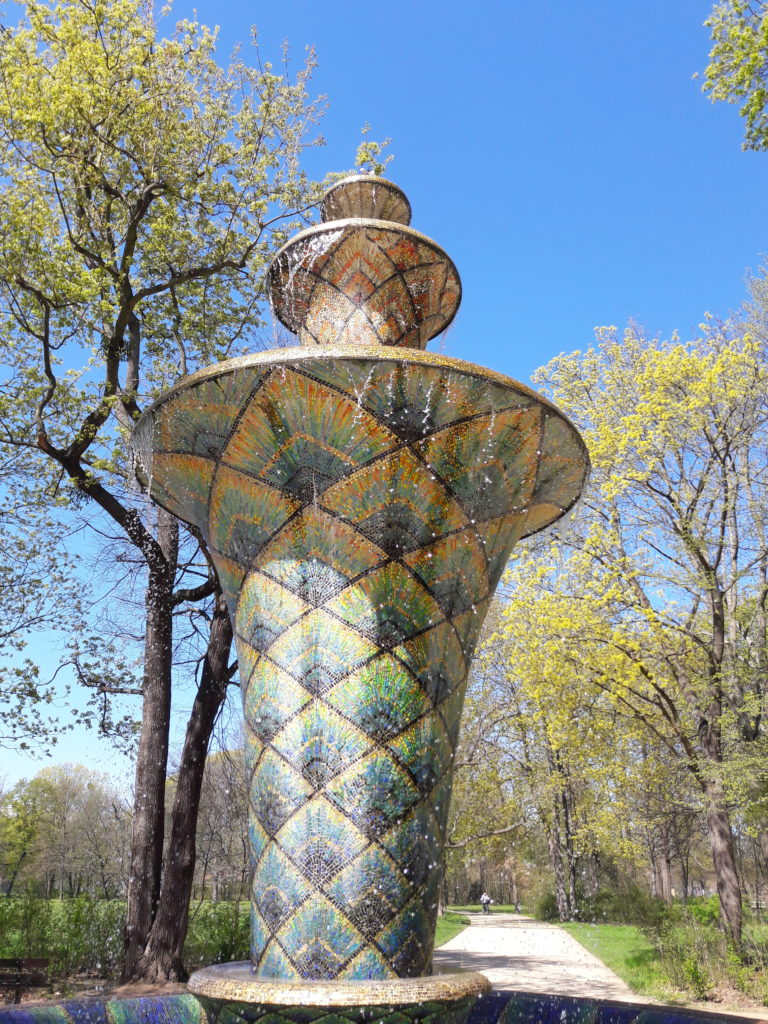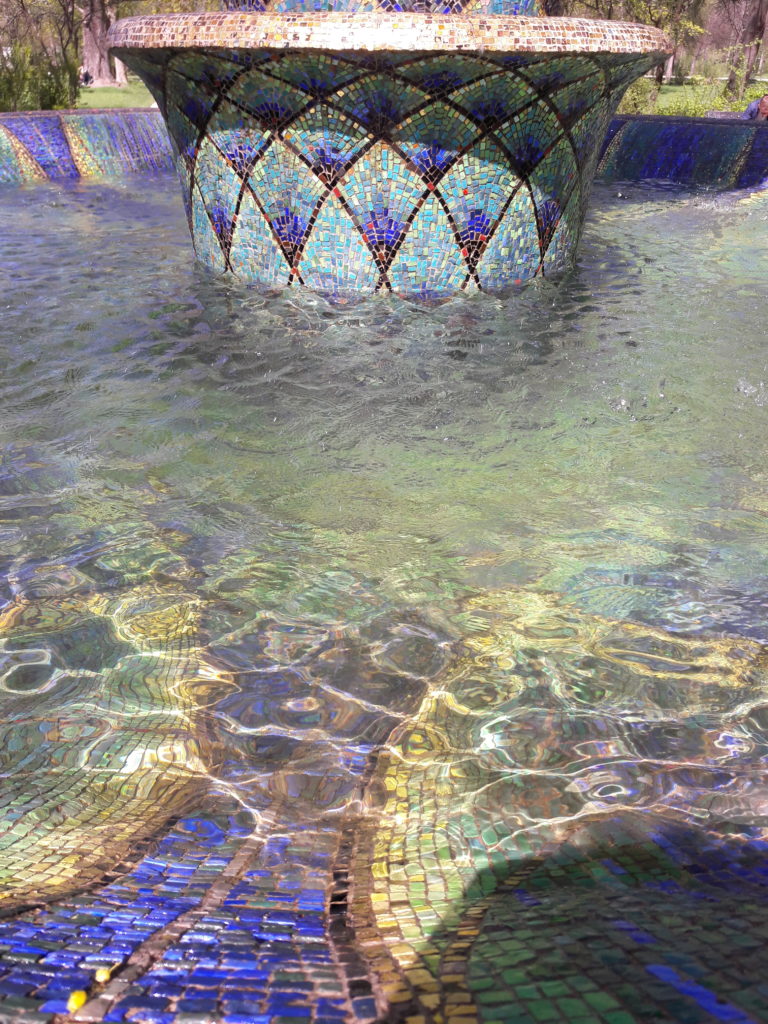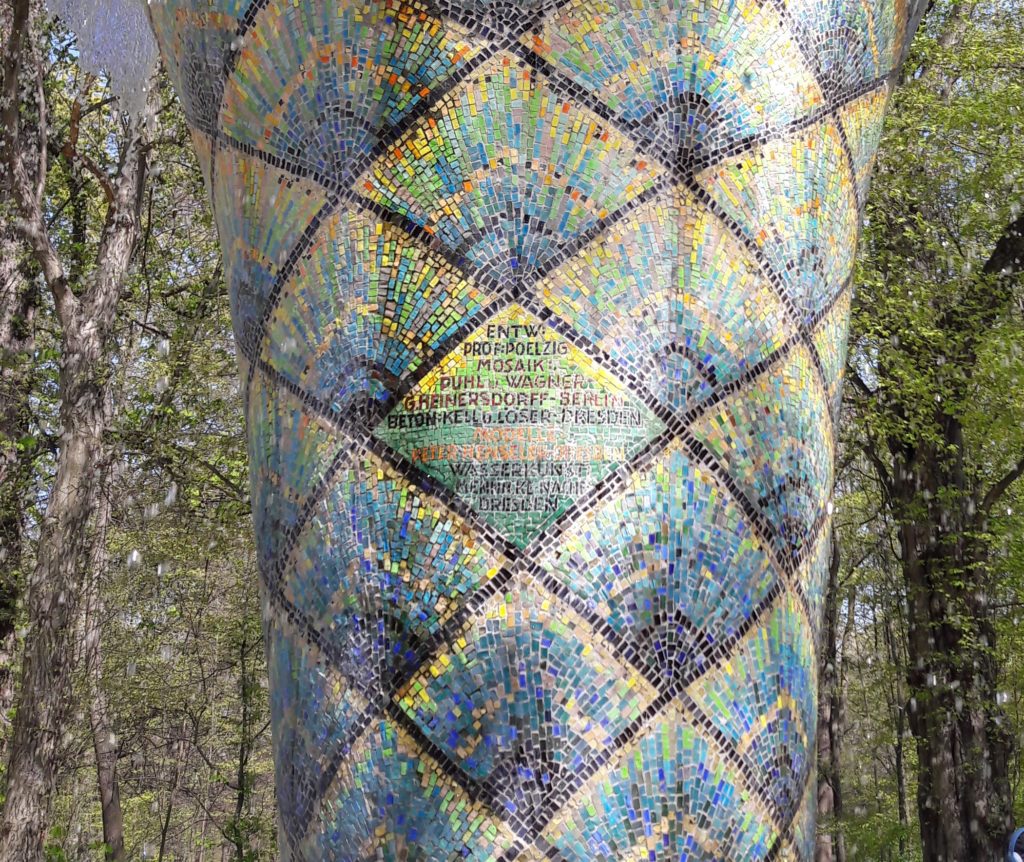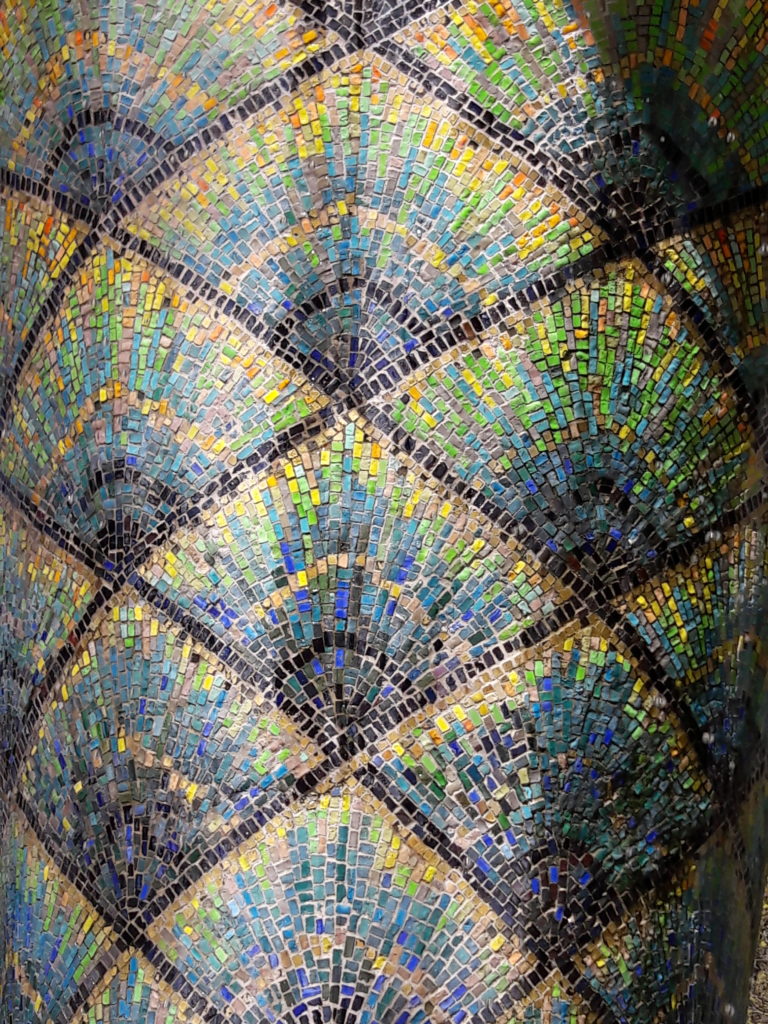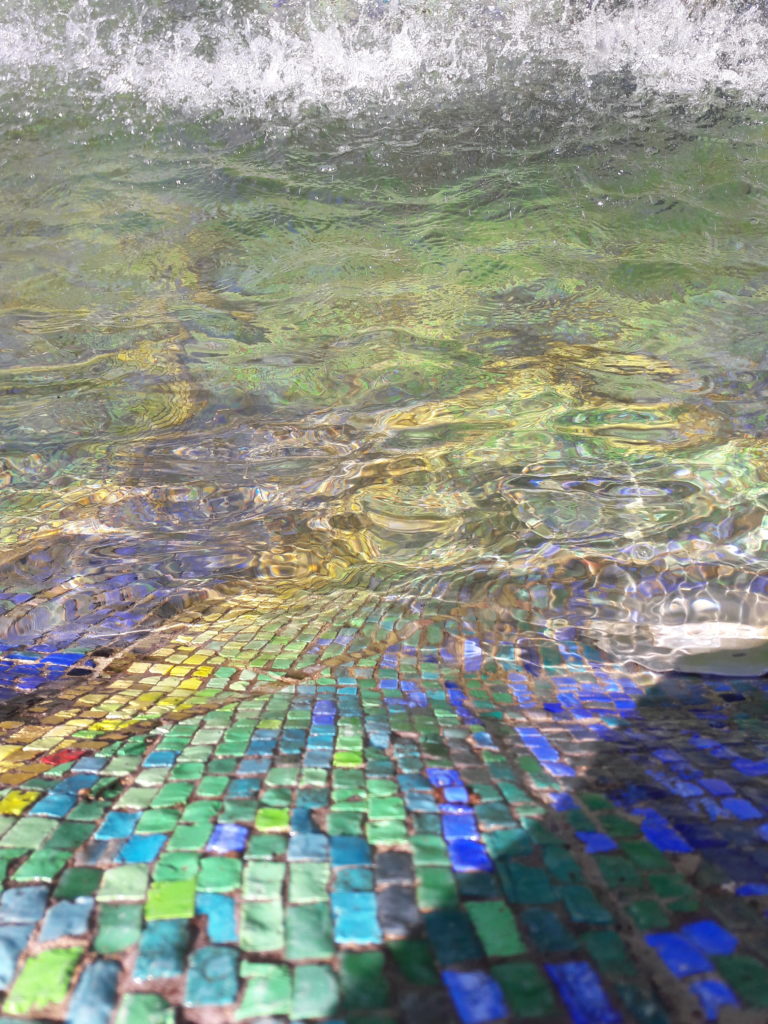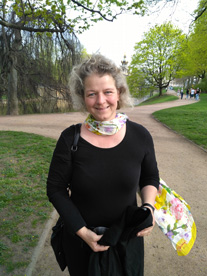Beauty, Truth and Opulence
am 30. April 2021 von Susanne Reichelt
Nature and Culture in Dresden’s Grand Garden
Vermeer’s “Girl reading a letter at the open window” has to wait once again, the special exhibition in the Old Masters Picture Gallery on this painting and its spectacular restoration has been postponed again and will now not open until September. So the preparation for it is not so hurried and I can use this blue-sky day for an extensive bike ride in the Grand Garden.
In the heart of the park at the Palais
Today I want to go in search of the truth. More precisely: of the truth being revealed by time. Even more precisely: of the sculpture group “Time revealing Truth” by Pietro Corradini, which stood near Carolasee Lake before its restoration and was given a new position near the Palais about 2 years ago, but I have never noticed it.
The Palais is the centrepiece of the Grand Garden, standing exactly in the middle of the park, at the intersection of the main avenue, which is about 2 km long, and the transverse avenue, which is half as long. This is just as it should be in a Baroque park, as are the boxwood trees precisely trimmed to cones around the lawn at the palace and the symmetrically arranged cavalier houses. There were three more of these, but they were so badly destroyed in World War II that they were not rebuilt. The magnificent interior architecture of the palace itself was not restored either, only the outer façades. If you look at it carefully, with a little imagination you can recognise the initials JG3C, which stand for the builder: Elector Johann Georg III, the father of the well-known Augustus the Strong.
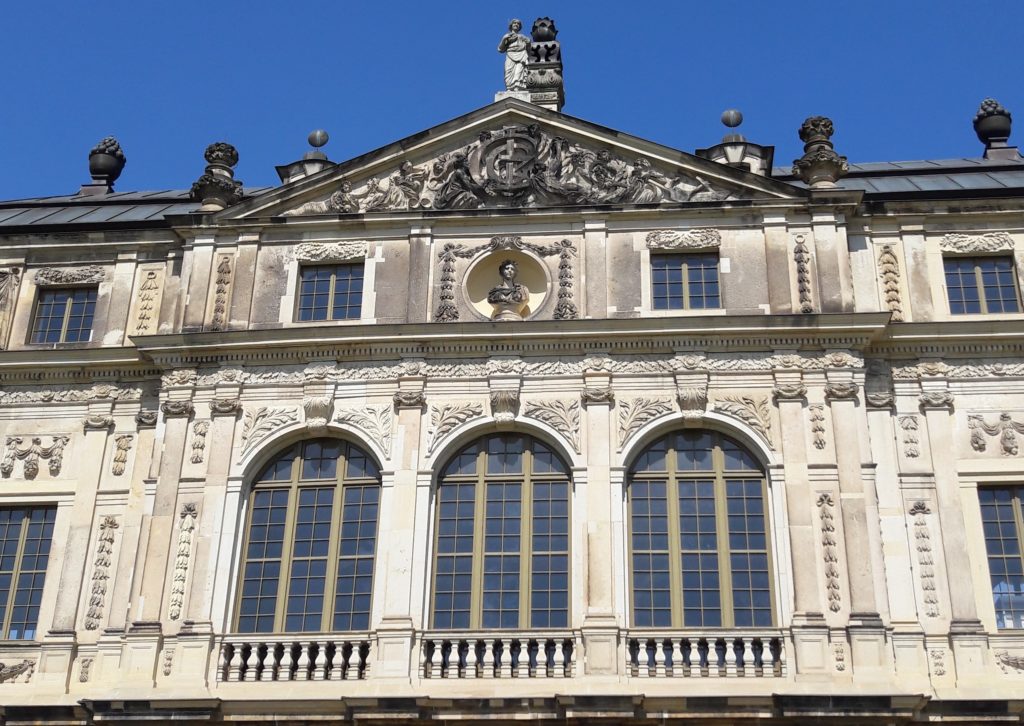
Initials JG3C n the triangular gable 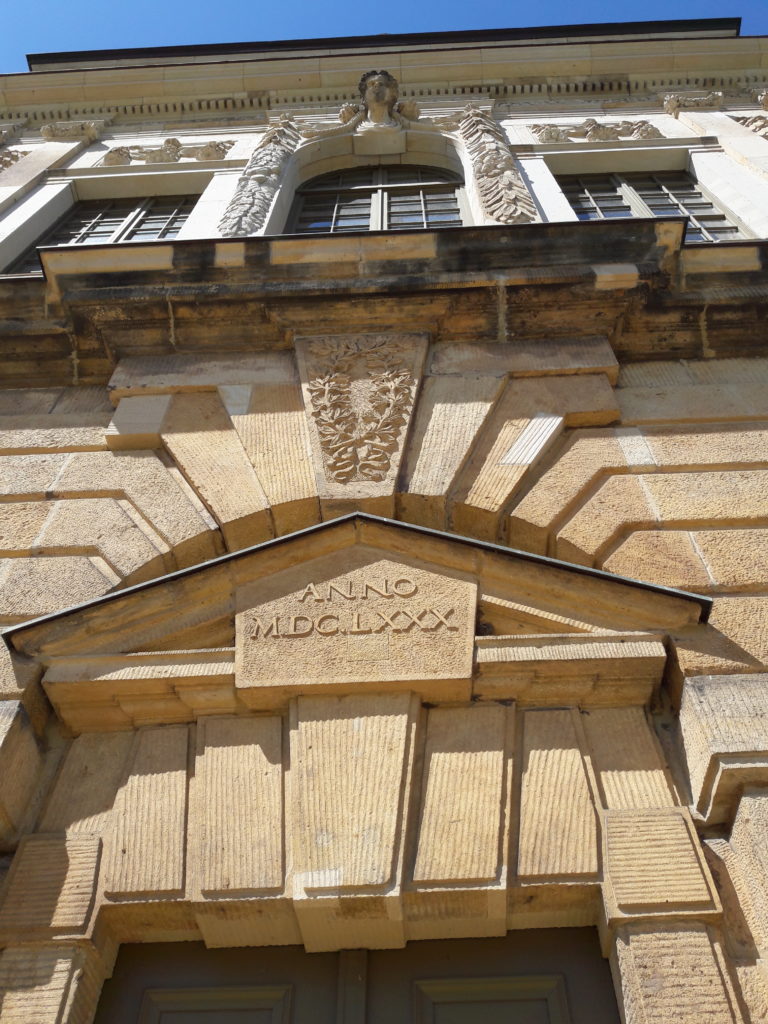
Anno MDCLXXX 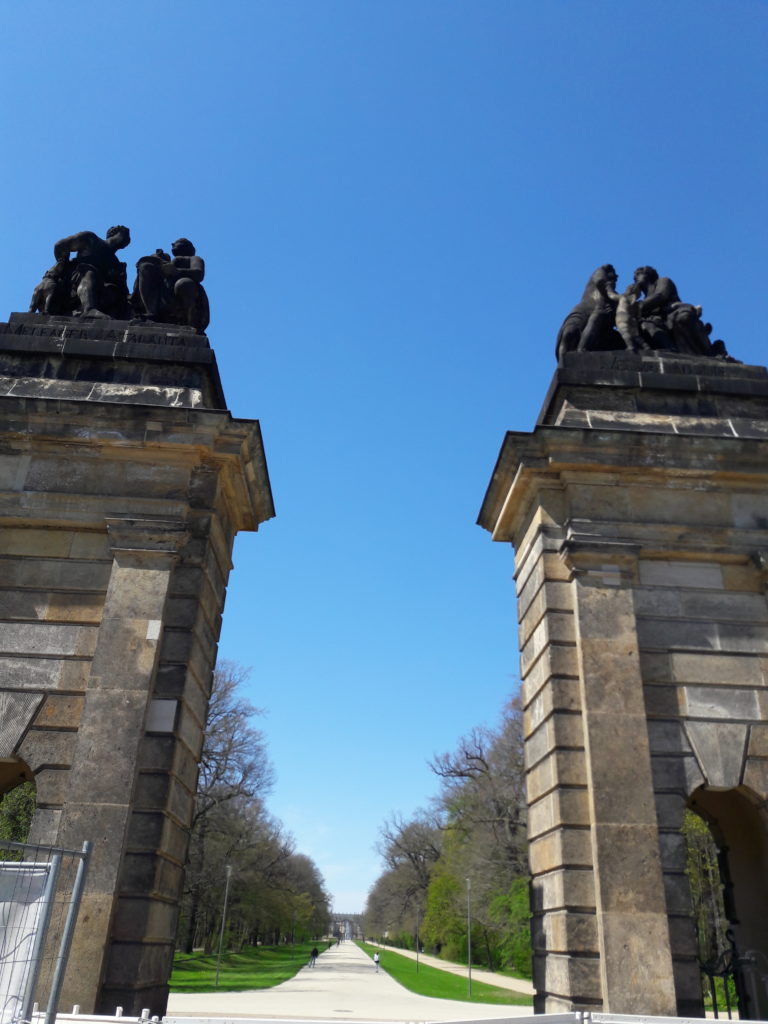
Eastern entry to the main avenue
The Roman date MDCLXXX – i.e. 1680 – can also be found. The palace is considered to be the first baroque building in Dresden; it was built about 30 years before work began on the Zwinger. Strictly speaking, however, it was not built in Dresden at the time, but in the countryside far outside the city walls and gates. The farmers in the surrounding villages of Striesen, Gruna and Strehlen were made sell their fields to the ruler, who never intended to actually settle down here, but to have another pleasure ground fitted with a palace and garden for diverse courtly festivals. The Venus Festival of 1719 must have been a particularly pleasurable occasion here, when Augustus the Strong married his son to a Habsburg princess. On the occasion of this so-called “wedding of the century” a whole series of parties was organized, each of them dedicated to one of the planetary gods. The baroque hedgerow theatre to the south of the palace still retains the additional scenery erected especially for this celebration.
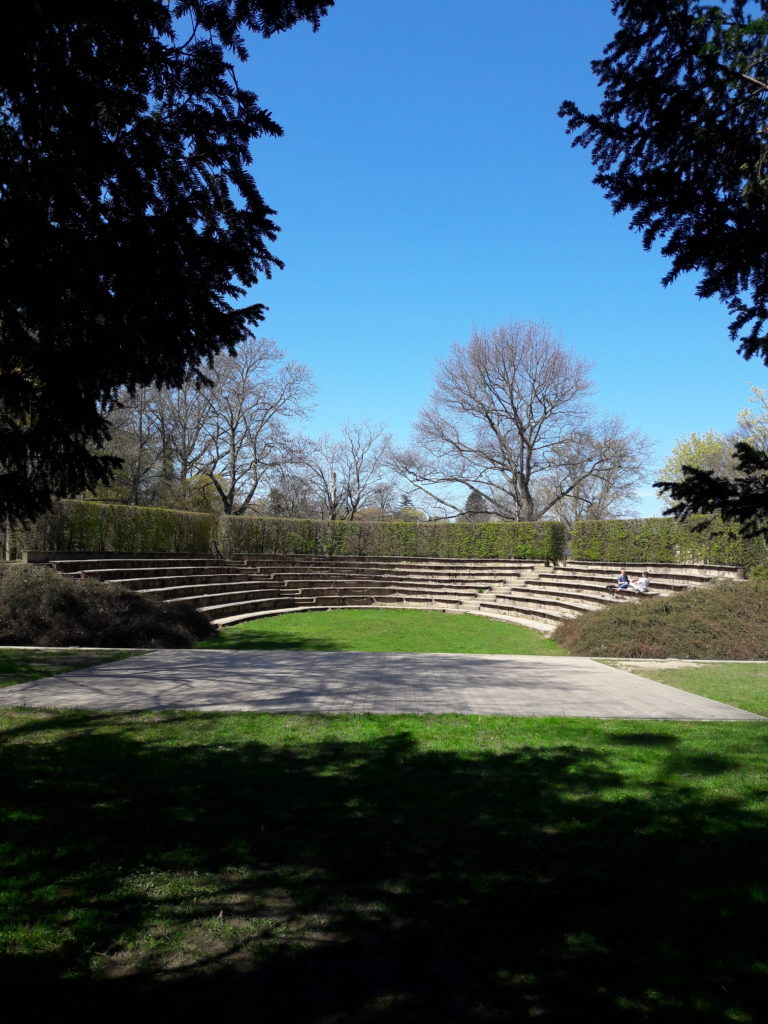
Baroque hedge theatre 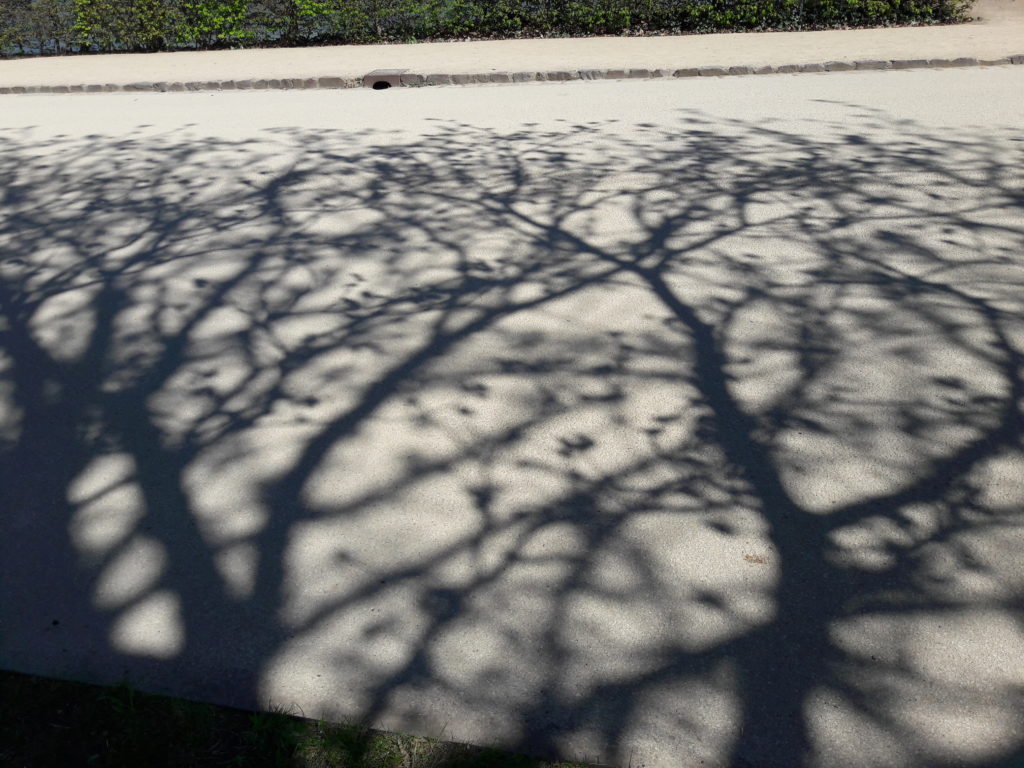
Light and shade 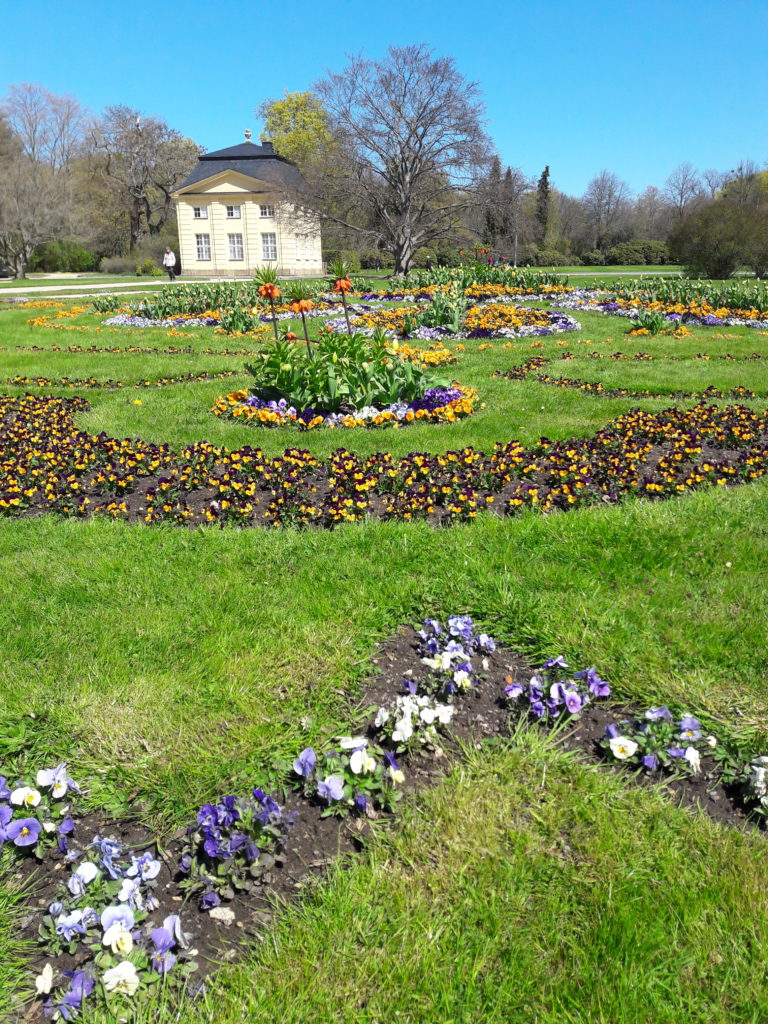
Carpet flower bed
Dramas in marble and the charms of Psyche
Most of the figures now on display near the Palais were not yet present at the festival. The marble sculptures in particular were only moved here from the garden of the Japanese Palace in 1728, including several by the aforementioned Corradini. The much-photographed “Vase of Opulence”, for example, which attracts attention quite prominently at the Palais pond. Above all, this is probably because of delicate Psyche, rather more revealing than too opulent, lolling lasciviously against the wall of the vessel, while the teasing Cupid opposite is ostentatiously looking in the opposite direction. Quite different from this work of Corradini’s with its quiet and subtle charm are the two dramatically moved groups of figures on both sides of the main avenue on the other side of the palace, which catch the eye of every passer-by. Here, centaurs, i.e. mixed creatures of horse and man, are in the process of raping a female creature who is understandably less than enthusiastic about this idea. They base on exciting mythological stories, too, but you don’t really need to know them, you can understand the drama of the events, which the sculptor has realised in such a gripping way.
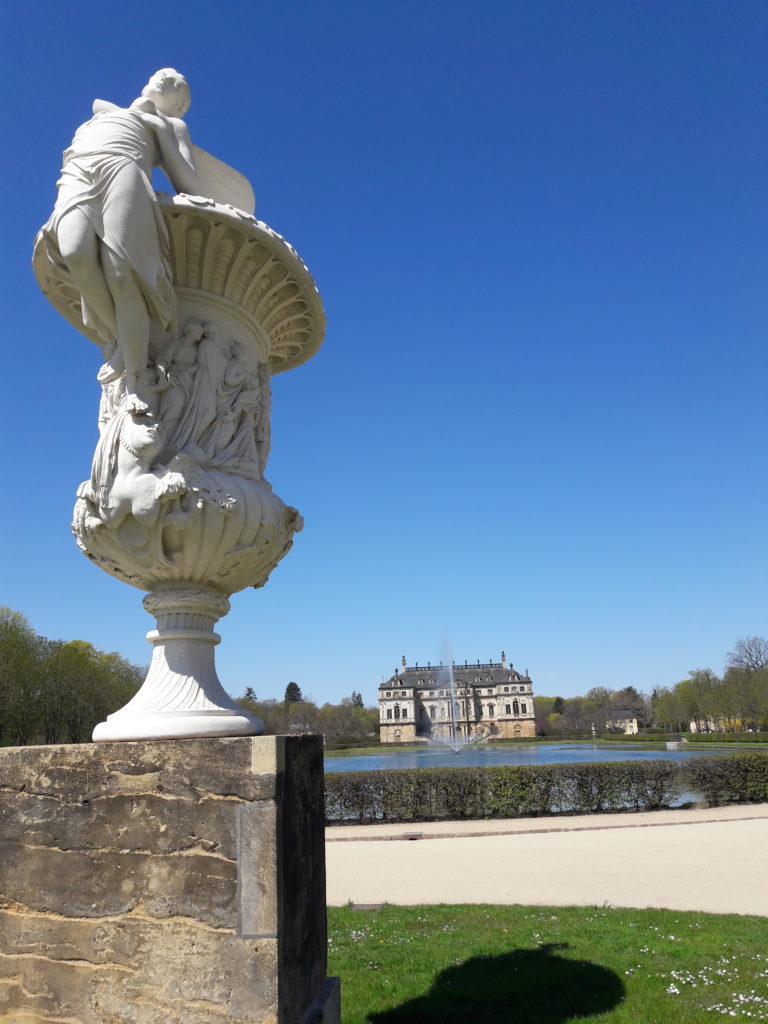
Vase of Opulence with Psyche… 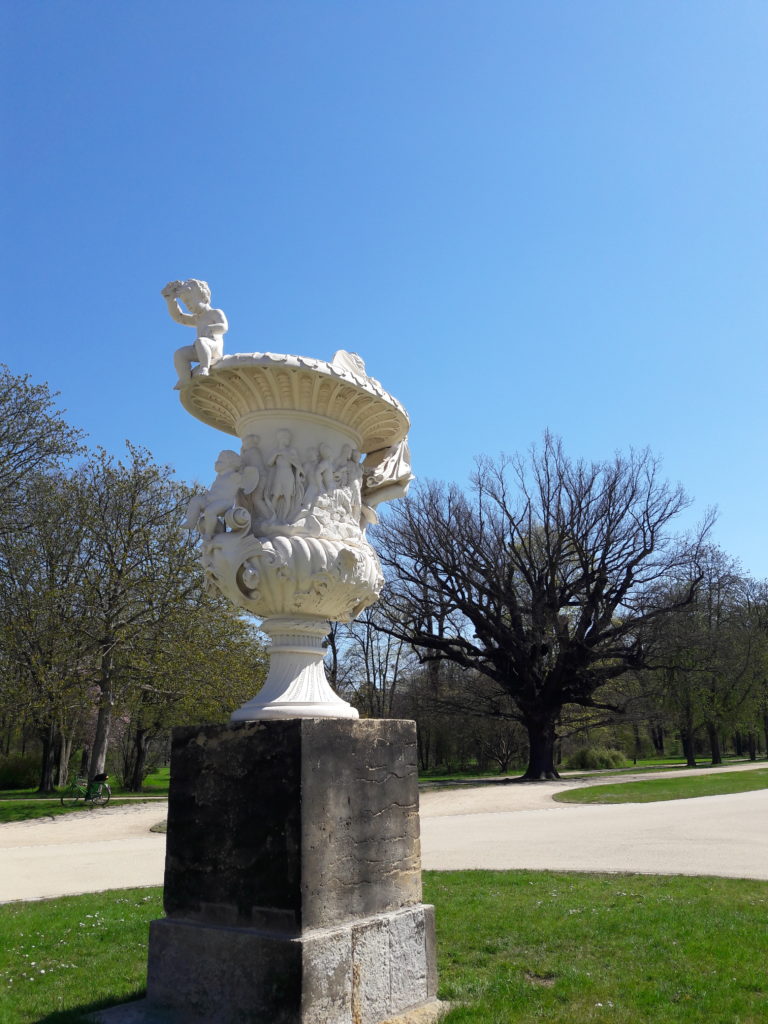
…and Amor 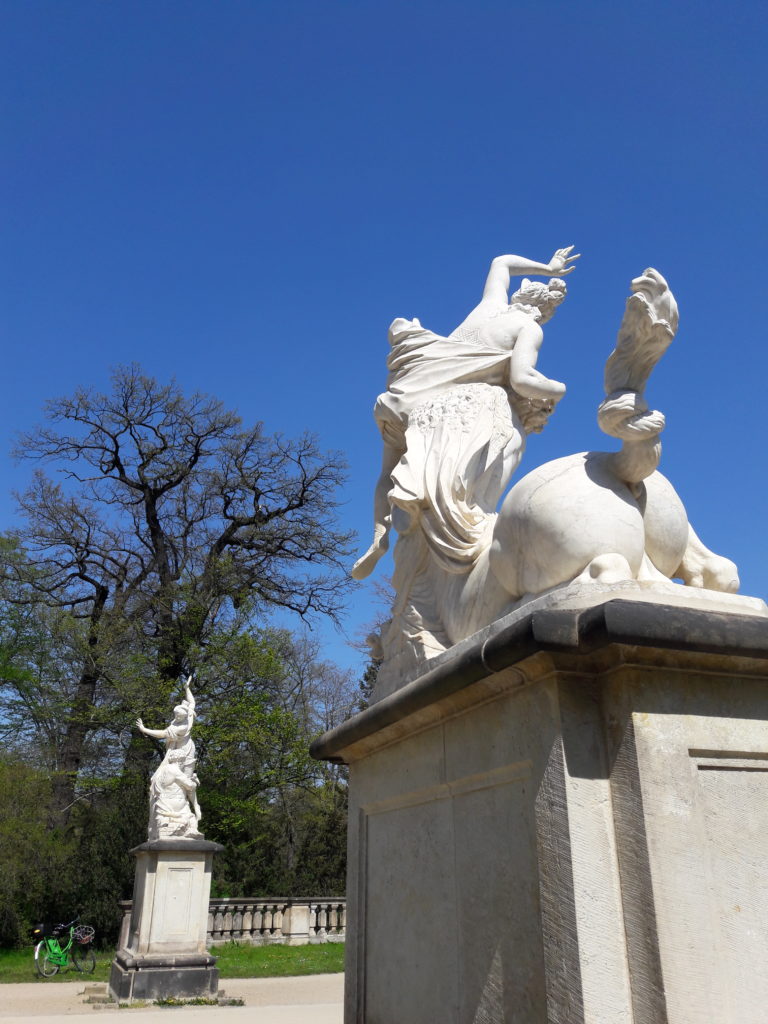
Group of centaurs in main avenue
On the trail of “Truth”
If you look back at the Palais from here, a box-shaped scaffolding has been disturbing the view for years. What makes good partly at least for the missing effect is a covering banner showing on a photo what is behind it during the restoration: the marble group “Time abducting Beauty” – no, this time not by Corradini, but by his compatriot Pietro Balestra. It is the thematic counterpart to Corradini’s “Time revealing Truth”, which I am on my way to discover.
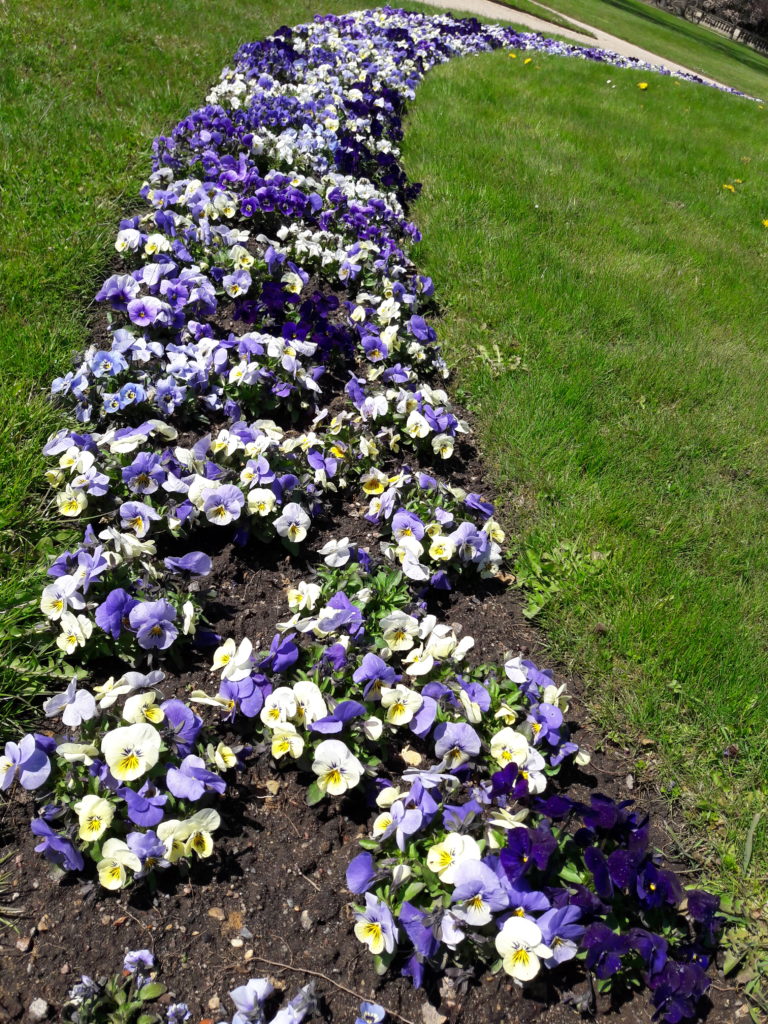
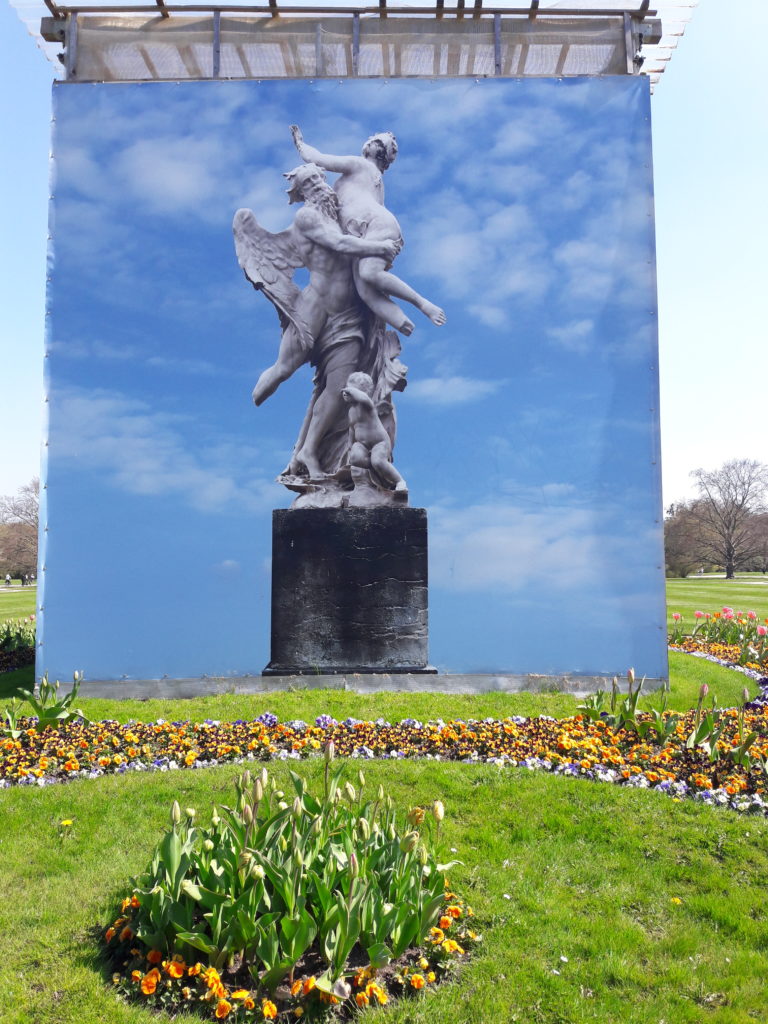
Under cover: Time abducting Beauty 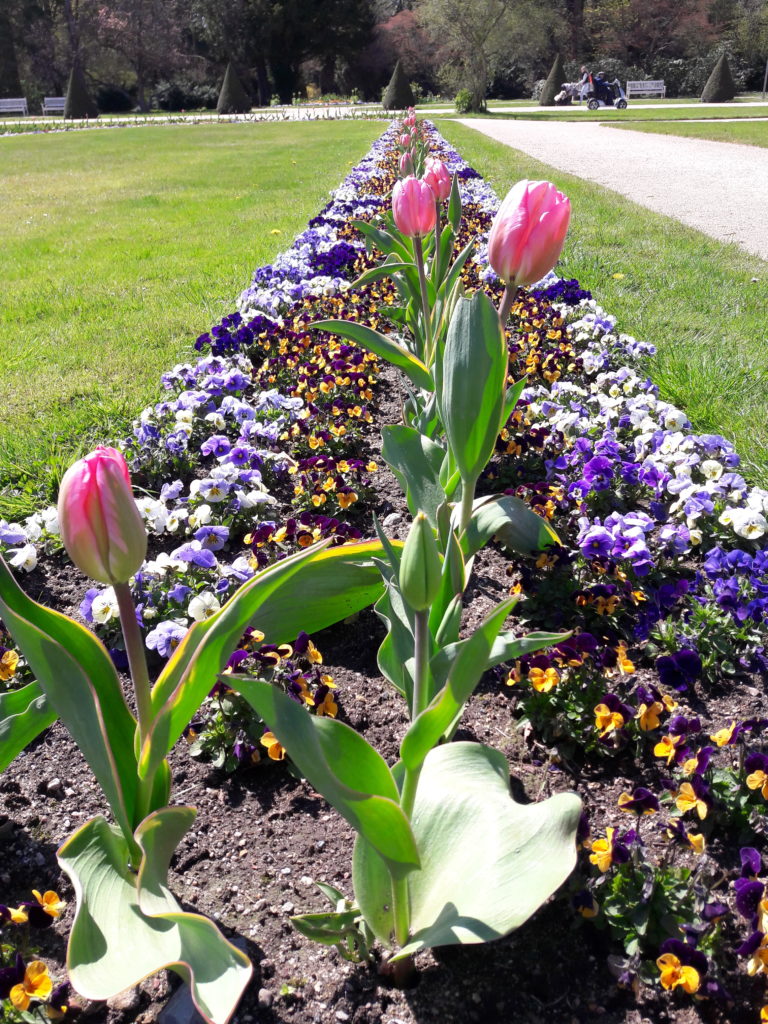
Both counterparts were moved within the Grand Garden in the 19th century, and since then “Beauty” has persevered in its precarious position in front of the palace. What regards “Truth”, however, nobody really knows where it went, well, it is often not so easy to search for the truth… Before its recent restoration it was placed in a less conspicuous location near Carolasee Lake, now it should have a more effective appearance again. And that’s where I am spotting it: at the level of the Palaisteich fountain there is a new small aisle to the north. And there it shines snow-white as an effective focal point of this visual axis: “Truth” – a naked young woman with a veil in front of her face, which is being pulled away by “Time” – a bearded old man. Masterful, how the woman’s face emerges from under the delicate veil or how the man’s fingers press into the woman’s body. And not to forget: It is not a cast, not a copy, it is the – restored – original!
From the cross to the rectangle
The Grand Garden has seen a lot of change and is in a way a reflection of history. At the end of the 19th century, when the city continued to grow and gradually enclosed the park, it was thanks to the garden administrator of the time, Friedrich Bouché, that the immediately adjacent areas were saved from the eager building activities of the wealthy citizens. Thus the area of the Grand Garden, which until then had been laid out in a cruciform shape, could be extended to form an approximate rectangle, which is only “nibbled” a little in the southwest by the zoo. In the south-east, a former gravel pit was turned into the idyllic Carolasee Lake, opposite on the Gruna side the canal was extended to form the Neuteich pond, in the direction towards the city the Botanical Garden was added and finally, at the north-west corner, where the VW factory now stands, the Exhibition Palace, inaugurated for the II International Horticultural Exhibition in 1896.
The magic of water, colour and light
Thirty years later, in 1926, the Flora Horticultural Society celebrated its 100th anniversary with a magnificent jubilee garden show in the Grand Garden. Hans Poelzig’s mosaic fountain is still preserved as a magical “relic” of that event. This is not so self-evident, usually, such exhibition displays only had a short life and the demolition of the fountain was already a done deal, despite all the efforts of the architect and his wife. Fortunately, this did not happen and it was allowed to remain. The bombs of the Second World War, which hit a huge oak tree only 100 metres away, miraculously spared it to a large extent. Even after that, it was often in a bad condition and had to survive several “dry periods” interrupted by repeated efforts of repair. Its last renovation was only 5 years ago, and since then it has even been allowed to bubble drinking water, which is supposed to protect it due to its lower lime content. I don’t begrudge it this special treatment. I can’t get enough of the wonderful colours of the mosaic stones, which shine in the sun and always look different under the moving water.
I stand by the fountain for a long time and watch the magical play of colours and water, and whoever passes by is enchanted or at least takes a photo of it. The Grand Garden has something in store for everyone, may he or she prefer to trace back history or to marvel at the wonders of nature, or simply wants to relax, dream, stroll. I am returning home happily having again enjoyed a mixture of all of it.
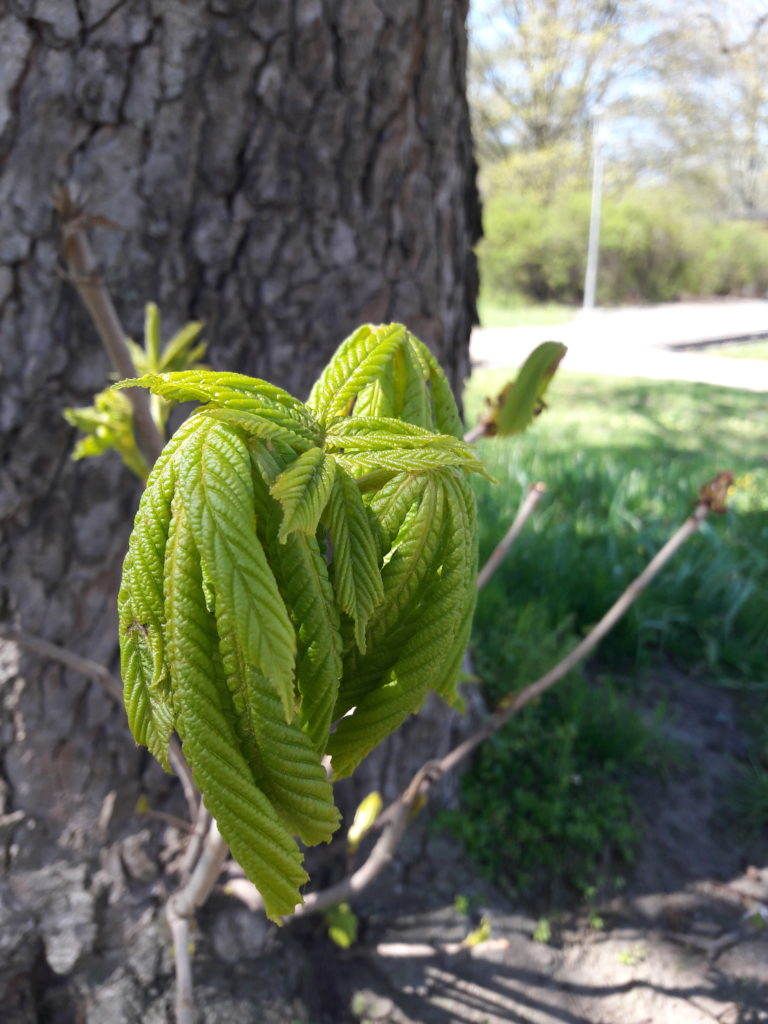
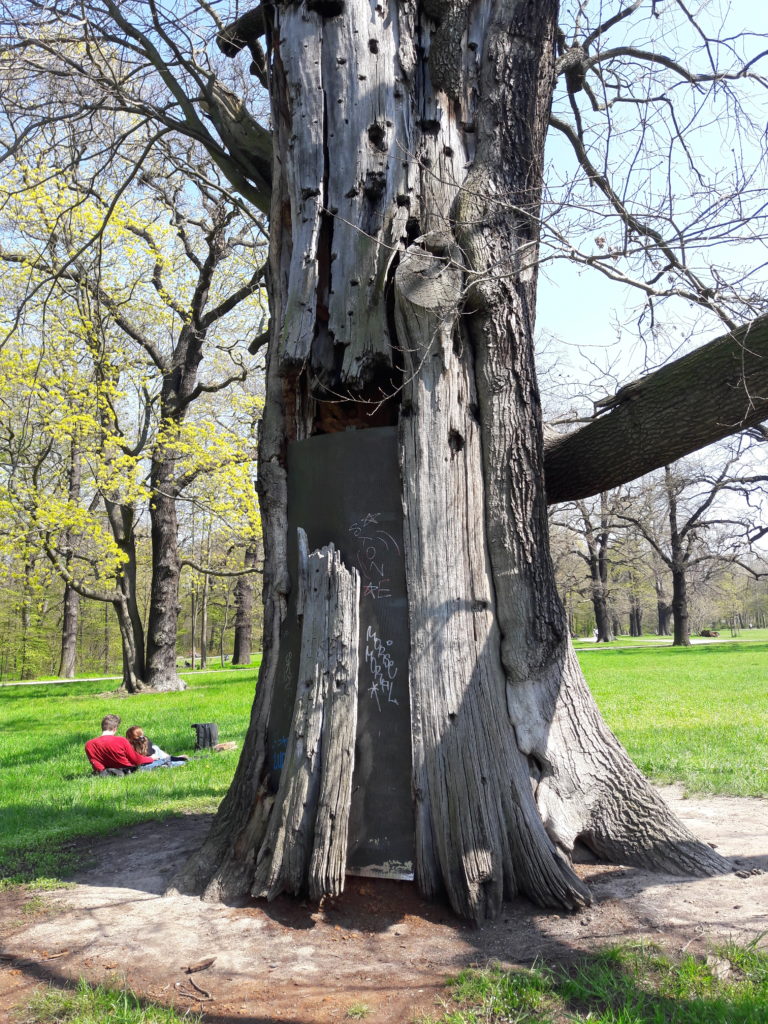
Old scars – young love 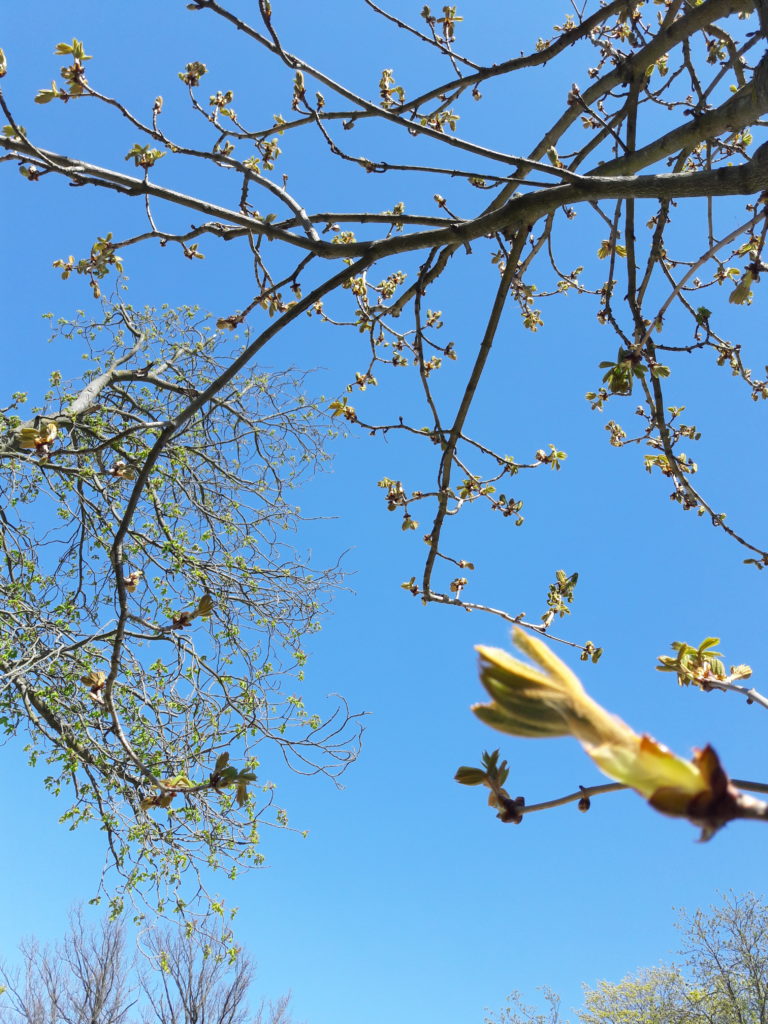
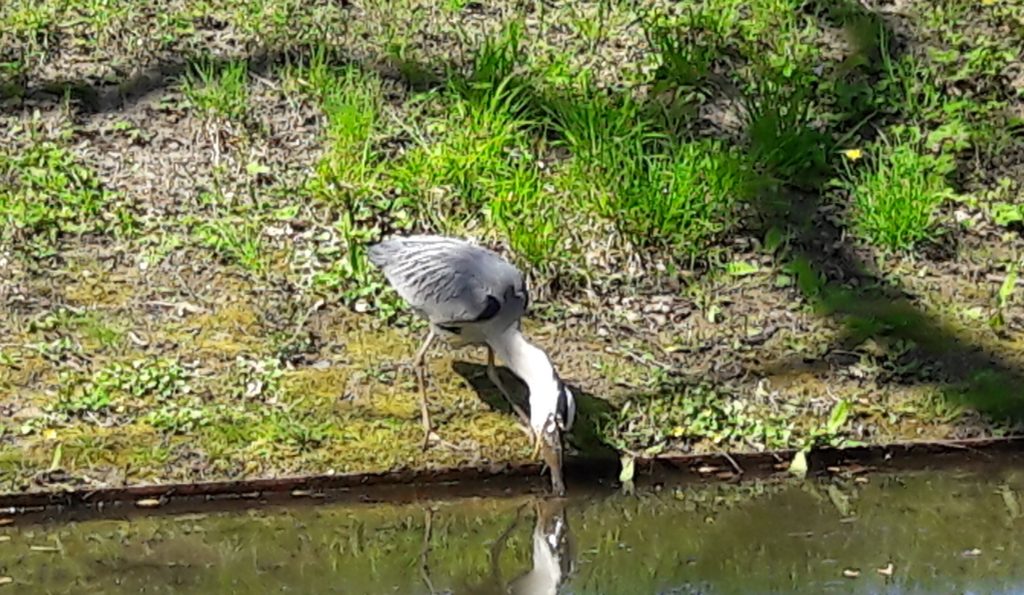
Heron gulping his fat prey 
Gnarled old oak – one of my favourite trees
Beauty, Truth and Opulence
on 30. April 2021 by Susanne Reichelt
Nature and Culture in Dresden’s Grand Garden
Vermeer’s “Girl reading a letter at the open window” has to wait once again, the special exhibition in the Old Masters Picture Gallery on this painting and its spectacular restoration has been postponed again and will now not open until September. So the preparation for it is not so hurried and I can use this blue-sky day for an extensive bike ride in the Grand Garden.
In the heart of the park at the Palais
Today I want to go in search of the truth. More precisely: of the truth being revealed by time. Even more precisely: of the sculpture group “Time revealing Truth” by Pietro Corradini, which stood near Carolasee Lake before its restoration and was given a new position near the Palais about 2 years ago, but I have never noticed it.
The Palais is the centrepiece of the Grand Garden, standing exactly in the middle of the park, at the intersection of the main avenue, which is about 2 km long, and the transverse avenue, which is half as long. This is just as it should be in a Baroque park, as are the boxwood trees precisely trimmed to cones around the lawn at the palace and the symmetrically arranged cavalier houses. There were three more of these, but they were so badly destroyed in World War II that they were not rebuilt. The magnificent interior architecture of the palace itself was not restored either, only the outer façades. If you look at it carefully, with a little imagination you can recognise the initials JG3C, which stand for the builder: Elector Johann Georg III, the father of the well-known Augustus the Strong.

Initials JG3C n the triangular gable 
Anno MDCLXXX 
Eastern entry to the main avenue
The Roman date MDCLXXX – i.e. 1680 – can also be found. The palace is considered to be the first baroque building in Dresden; it was built about 30 years before work began on the Zwinger. Strictly speaking, however, it was not built in Dresden at the time, but in the countryside far outside the city walls and gates. The farmers in the surrounding villages of Striesen, Gruna and Strehlen were made sell their fields to the ruler, who never intended to actually settle down here, but to have another pleasure ground fitted with a palace and garden for diverse courtly festivals. The Venus Festival of 1719 must have been a particularly pleasurable occasion here, when Augustus the Strong married his son to a Habsburg princess. On the occasion of this so-called “wedding of the century” a whole series of parties was organized, each of them dedicated to one of the planetary gods. The baroque hedgerow theatre to the south of the palace still retains the additional scenery erected especially for this celebration.

Baroque hedge theatre 
Light and shade 
Carpet flower bed
Dramas in marble and the charms of Psyche
Most of the figures now on display near the Palais were not yet present at the festival. The marble sculptures in particular were only moved here from the garden of the Japanese Palace in 1728, including several by the aforementioned Corradini. The much-photographed “Vase of Opulence”, for example, which attracts attention quite prominently at the Palais pond. Above all, this is probably because of delicate Psyche, rather more revealing than too opulent, lolling lasciviously against the wall of the vessel, while the teasing Cupid opposite is ostentatiously looking in the opposite direction. Quite different from this work of Corradini’s with its quiet and subtle charm are the two dramatically moved groups of figures on both sides of the main avenue on the other side of the palace, which catch the eye of every passer-by. Here, centaurs, i.e. mixed creatures of horse and man, are in the process of raping a female creature who is understandably less than enthusiastic about this idea. They base on exciting mythological stories, too, but you don’t really need to know them, you can understand the drama of the events, which the sculptor has realised in such a gripping way.

Vase of Opulence with Psyche… 
…and Amor 
Group of centaurs in main avenue
On the trail of “Truth”
If you look back at the Palais from here, a box-shaped scaffolding has been disturbing the view for years. What makes good partly at least for the missing effect is a covering banner showing on a photo what is behind it during the restoration: the marble group “Time abducting Beauty” – no, this time not by Corradini, but by his compatriot Pietro Balestra. It is the thematic counterpart to Corradini’s “Time revealing Truth”, which I am on my way to discover.


Under cover: Time abducting Beauty 
Both counterparts were moved within the Grand Garden in the 19th century, and since then “Beauty” has persevered in its precarious position in front of the palace. What regards “Truth”, however, nobody really knows where it went, well, it is often not so easy to search for the truth… Before its recent restoration it was placed in a less conspicuous location near Carolasee Lake, now it should have a more effective appearance again. And that’s where I am spotting it: at the level of the Palaisteich fountain there is a new small aisle to the north. And there it shines snow-white as an effective focal point of this visual axis: “Truth” – a naked young woman with a veil in front of her face, which is being pulled away by “Time” – a bearded old man. Masterful, how the woman’s face emerges from under the delicate veil or how the man’s fingers press into the woman’s body. And not to forget: It is not a cast, not a copy, it is the – restored – original!
From the cross to the rectangle
The Grand Garden has seen a lot of change and is in a way a reflection of history. At the end of the 19th century, when the city continued to grow and gradually enclosed the park, it was thanks to the garden administrator of the time, Friedrich Bouché, that the immediately adjacent areas were saved from the eager building activities of the wealthy citizens. Thus the area of the Grand Garden, which until then had been laid out in a cruciform shape, could be extended to form an approximate rectangle, which is only “nibbled” a little in the southwest by the zoo. In the south-east, a former gravel pit was turned into the idyllic Carolasee Lake, opposite on the Gruna side the canal was extended to form the Neuteich pond, in the direction towards the city the Botanical Garden was added and finally, at the north-west corner, where the VW factory now stands, the Exhibition Palace, inaugurated for the II International Horticultural Exhibition in 1896.
The magic of water, colour and light
Thirty years later, in 1926, the Flora Horticultural Society celebrated its 100th anniversary with a magnificent jubilee garden show in the Grand Garden. Hans Poelzig’s mosaic fountain is still preserved as a magical “relic” of that event. This is not so self-evident, usually, such exhibition displays only had a short life and the demolition of the fountain was already a done deal, despite all the efforts of the architect and his wife. Fortunately, this did not happen and it was allowed to remain. The bombs of the Second World War, which hit a huge oak tree only 100 metres away, miraculously spared it to a large extent. Even after that, it was often in a bad condition and had to survive several “dry periods” interrupted by repeated efforts of repair. Its last renovation was only 5 years ago, and since then it has even been allowed to bubble drinking water, which is supposed to protect it due to its lower lime content. I don’t begrudge it this special treatment. I can’t get enough of the wonderful colours of the mosaic stones, which shine in the sun and always look different under the moving water.
I stand by the fountain for a long time and watch the magical play of colours and water, and whoever passes by is enchanted or at least takes a photo of it. The Grand Garden has something in store for everyone, may he or she prefer to trace back history or to marvel at the wonders of nature, or simply wants to relax, dream, stroll. I am returning home happily having again enjoyed a mixture of all of it.


Old scars – young love 

Heron gulping his fat prey 
Gnarled old oak – one of my favourite trees
